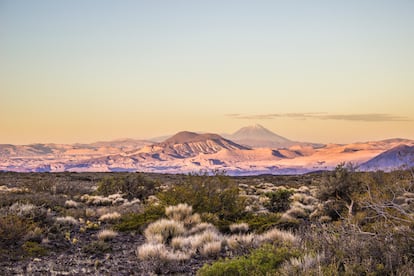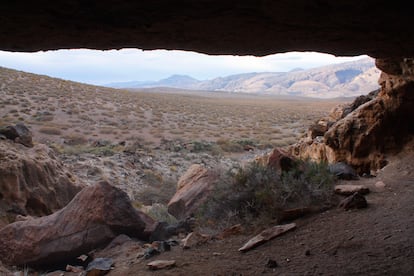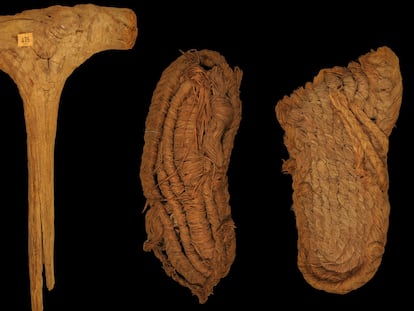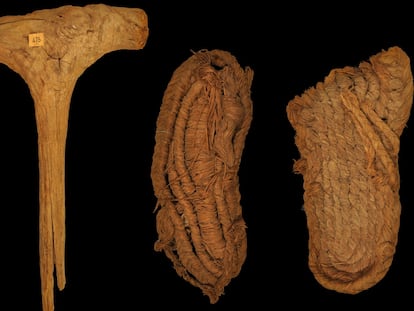Oldest rock art in South America dates back 8,200 years
Cave paintings in Argentina’s Patagonia region predate others in that area by several millennia, according to research published in ‘Science’
Thousands of years ago, humans started painting the walls of a cave in an inhospitable part of South America. They used red, yellow, white and black pigments to create various designs, including geometric shapes. However, the exact date of these drawings remained unknown until now. After more than a decade of work, scientists from Argentina, Chile and the United States have successfully dated the Huenul 1 cave paintings in Argentina’s Patagonia region. According to a paper in Science magazine, the oldest paintings in the cave date back 8,200 years, several millennia earlier than previously suggested by ancient rock art in that area.
“It’s a milestone in the rock art tradition of South America,” said archaeologist Guadalupe Romero Villanueva, the lead author of the research article. She explained that dating rock art often relies on comparative methods, like evaluating evidence from the same or related sites to establish a chronology. While this is a valid dating approach, the archaeology team led by Romero used more precise direct dating. “These studies can be quite complex and don’t always produce solid results,” she said.

A series of “lucky” breaks helped the scientists pursue the direct dating method. “There were sufficient carbon deposits with no contamination layers,” said Romero. This enabled the team to use carbon-14 (radiocarbon) dating on four samples, finding that the oldest painting dates back 7,600 years. The other three paintings were dated to approximately 6,200, 5,600 and 3,000 years ago, based on calibrated data. Using statistical modeling, the researchers refined the data and determined that the first rock art in the cave was painted 8,200 years ago.
Romero, a researcher with Argentina’s National Scientific and Technical Research Council (CONICET) and the National Institute of Anthropology and Latin American Thought (INAPL), began analyzing the art on the walls of the Huenul 1 cave a decade ago with Ramiro Barberena. The scarce existing research about the cave paintings was done in the 1970s and 1980s. Romero estimates that most of the cave’s artwork was created 2,000 years ago, during its peak occupation. “The surprise was that some of the motifs [paintings] are actually quite a bit older,” she said.
The cave, in the northwest corner of Argentina’s Neuquén province, is unique in the region due to the quantity and variety of its rock art. With over 440 motifs painted with diluted pigments and applied by fingers and utensils, the drawings mainly consist of geometric shapes created over hundreds of years. Scientists have identified continuity in the style, colors and materials used, which indicates that the cave was repeatedly occupied by various groups.
The cave was frequented by hunter-gatherers who occupied it for brief and recurring episodes, particularly during the late Holocene period (the current geological epoch). Extremely dry conditions kept South America sparsely populated during this period. Romero says small, dispersed groups would have needed a central spot to visually preserve their ecological and ritual knowledge. The rock art played a crucial role in this process.

A strategy for socioecological resilience
Romero and her team say that “standardized pictorial events” in the Patagonian cave aimed to maintain large-scale safety nets. These pictures stored information in collective memory and ensured social preservation beyond oral tradition. “Rock art tied to a site turned by transgenerational practices into a keystone cultural place facilitated social and biological connectivity in a sparsely populated high-cost landscape.”
Romero says the specific information conveyed by the paintings on the walls of the Huenul 1 cave has been lost and “cannot be recovered by archaeology... [But] the studies enable us to infer that they transmitted ecological and social information.” For instance, it was crucial for people to know the whereabouts of other humans, their potential as social connections, and the location of resources. “Documenting this information on a durable medium made the area more livable and was highly useful for future generations.”
“Knowing past events and solutions can be crucial for building human resilience,” said Romero. “The information collected over time can offer successful approaches to dealing with events like climate change.” The paper published in Science provides valuable and thoughtful context relevant to our world today. “Building social resilience to environmental change is one of the main challenges faced by humanity today. While its severity may suggest that this is unprecedented, human societies have confronted a myriad of socioecological challenges during the Holocene.”

Sign up for our weekly newsletter to get more English-language news coverage from EL PAÍS USA Edition
Tu suscripción se está usando en otro dispositivo
¿Quieres añadir otro usuario a tu suscripción?
Si continúas leyendo en este dispositivo, no se podrá leer en el otro.
FlechaTu suscripción se está usando en otro dispositivo y solo puedes acceder a EL PAÍS desde un dispositivo a la vez.
Si quieres compartir tu cuenta, cambia tu suscripción a la modalidad Premium, así podrás añadir otro usuario. Cada uno accederá con su propia cuenta de email, lo que os permitirá personalizar vuestra experiencia en EL PAÍS.
¿Tienes una suscripción de empresa? Accede aquí para contratar más cuentas.
En el caso de no saber quién está usando tu cuenta, te recomendamos cambiar tu contraseña aquí.
Si decides continuar compartiendo tu cuenta, este mensaje se mostrará en tu dispositivo y en el de la otra persona que está usando tu cuenta de forma indefinida, afectando a tu experiencia de lectura. Puedes consultar aquí los términos y condiciones de la suscripción digital.
More information
Archived In
Últimas noticias
The complicated life of Francesca Albanese: A rising figure in Italy but barred from every bank by Trump’s sanctions
From digital curfews to blocking apps: How technology experts protect their children online
Why the price of coffee has skyrocketed: from Brazilian plantations to specialty coffee houses
Confined to a Cuban hospital: When electricity is a matter of life or death
Most viewed
- Pablo Escobar’s hippos: A serious environmental problem, 40 years on
- Why we lost the habit of sleeping in two segments and how that changed our sense of time
- Trump’s obsession with putting his name on everything is unprecedented in the United States
- Charles Dubouloz, mountaineering star, retires at 36 with a farewell tour inspired by Walter Bonatti
- The Florida Keys tourist paradise is besieged by immigration agents: ‘We’ve never seen anything like this’










































